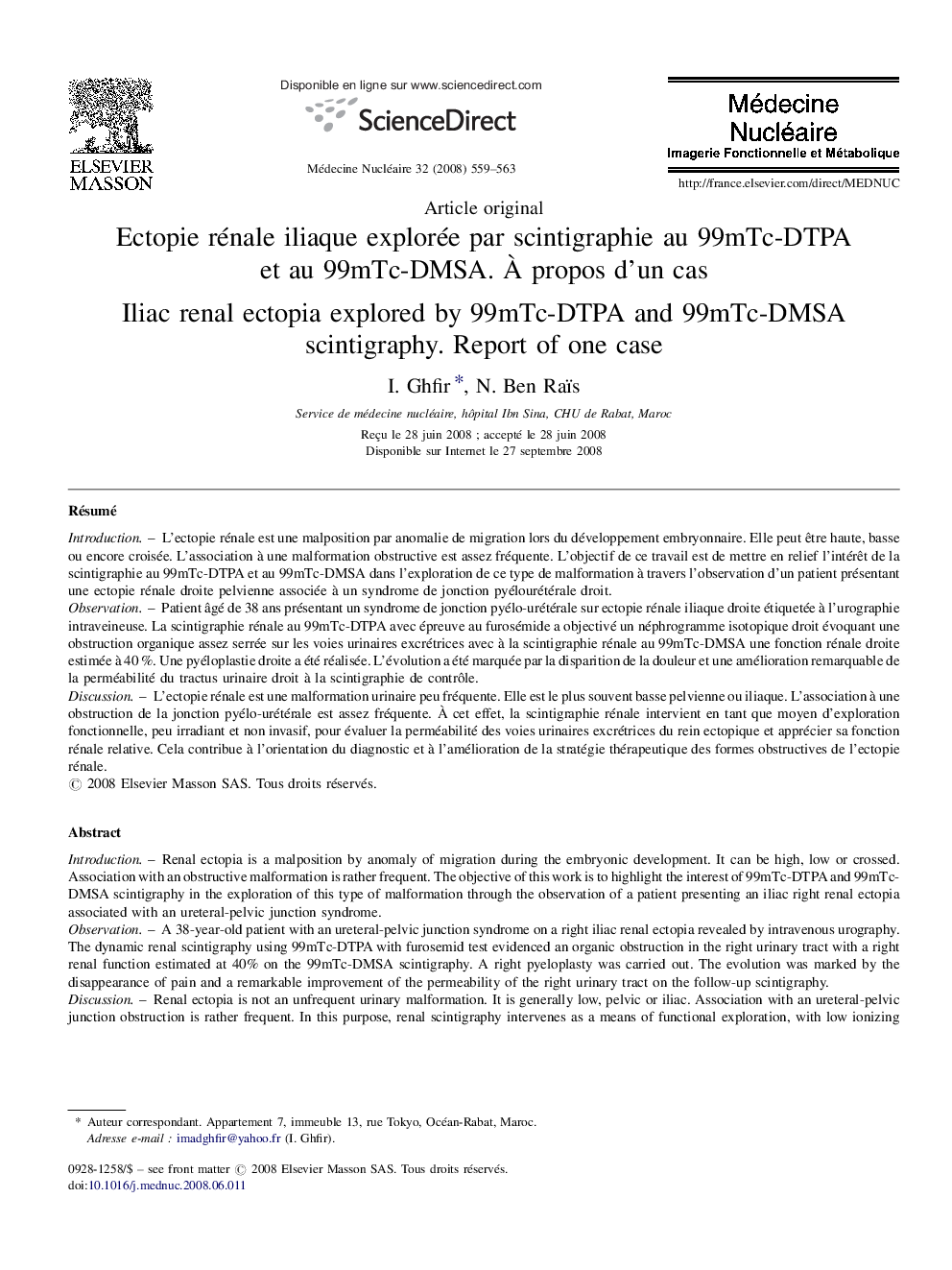| کد مقاله | کد نشریه | سال انتشار | مقاله انگلیسی | نسخه تمام متن |
|---|---|---|---|---|
| 4244857 | 1283429 | 2008 | 5 صفحه PDF | دانلود رایگان |

RésuméIntroductionL’ectopie rénale est une malposition par anomalie de migration lors du développement embryonnaire. Elle peut être haute, basse ou encore croisée. L’association à une malformation obstructive est assez fréquente. L’objectif de ce travail est de mettre en relief l’intérêt de la scintigraphie au 99mTc-DTPA et au 99mTc-DMSA dans l’exploration de ce type de malformation à travers l’observation d’un patient présentant une ectopie rénale droite pelvienne associée à un syndrome de jonction pyélourétérale droit.ObservationPatient âgé de 38 ans présentant un syndrome de jonction pyélo-urétérale sur ectopie rénale iliaque droite étiquetée à l’urographie intraveineuse. La scintigraphie rénale au 99mTc-DTPA avec épreuve au furosémide a objectivé un néphrogramme isotopique droit évoquant une obstruction organique assez serrée sur les voies urinaires excrétrices avec à la scintigraphie rénale au 99mTc-DMSA une fonction rénale droite estimée à 40 %. Une pyéloplastie droite a été réalisée. L’évolution a été marquée par la disparition de la douleur et une amélioration remarquable de la perméabilité du tractus urinaire droit à la scintigraphie de contrôle.DiscussionL’ectopie rénale est une malformation urinaire peu fréquente. Elle est le plus souvent basse pelvienne ou iliaque. L’association à une obstruction de la jonction pyélo-urétérale est assez fréquente. À cet effet, la scintigraphie rénale intervient en tant que moyen d’exploration fonctionnelle, peu irradiant et non invasif, pour évaluer la perméabilité des voies urinaires excrétrices du rein ectopique et apprécier sa fonction rénale relative. Cela contribue à l’orientation du diagnostic et à l’amélioration de la stratégie thérapeutique des formes obstructives de l’ectopie rénale.
IntroductionRenal ectopia is a malposition by anomaly of migration during the embryonic development. It can be high, low or crossed. Association with an obstructive malformation is rather frequent. The objective of this work is to highlight the interest of 99mTc-DTPA and 99mTc-DMSA scintigraphy in the exploration of this type of malformation through the observation of a patient presenting an iliac right renal ectopia associated with an ureteral-pelvic junction syndrome.ObservationA 38-year-old patient with an ureteral-pelvic junction syndrome on a right iliac renal ectopia revealed by intravenous urography. The dynamic renal scintigraphy using 99mTc-DTPA with furosemid test evidenced an organic obstruction in the right urinary tract with a right renal function estimated at 40% on the 99mTc-DMSA scintigraphy. A right pyeloplasty was carried out. The evolution was marked by the disappearance of pain and a remarkable improvement of the permeability of the right urinary tract on the follow-up scintigraphy.DiscussionRenal ectopia is not an unfrequent urinary malformation. It is generally low, pelvic or iliac. Association with an ureteral-pelvic junction obstruction is rather frequent. In this purpose, renal scintigraphy intervenes as a means of functional exploration, with low ionizing radiation and non-invasive to assess the permeability of the urinary tracts of the ectopic kidney and to appreciate the relative renal function. This contributes to the orientation of diagnosis and the improvement of therapeutic strategy.
Journal: Médecine Nucléaire - Volume 32, Issue 11, November 2008, Pages 559–563